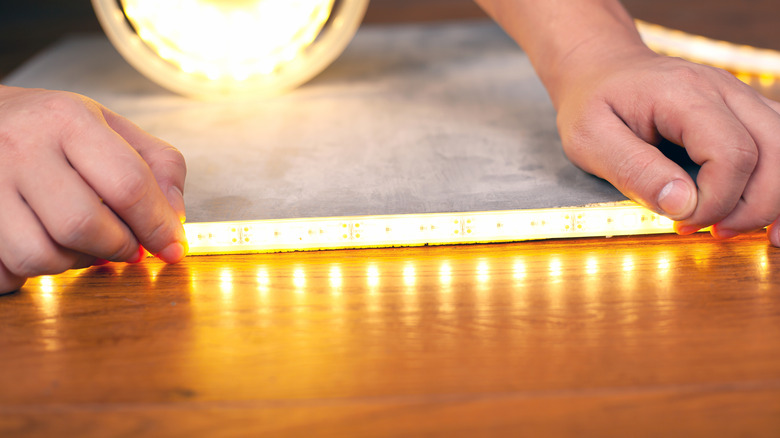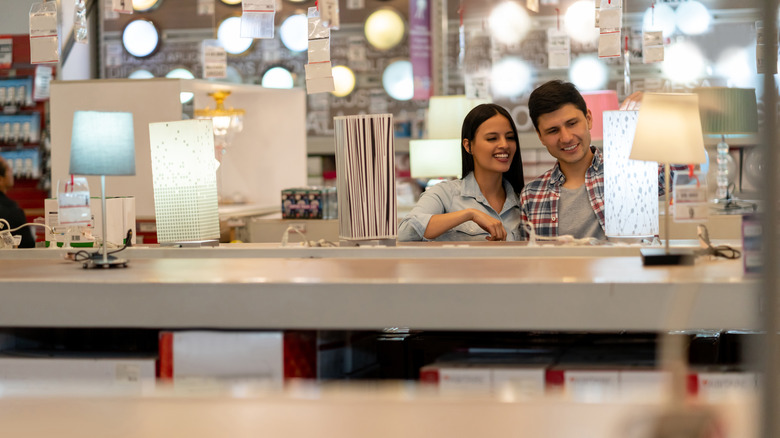The One Spot In Your Home To Add LED Light Strips For An Instantly Elevated Look
Gen Zers and Millennials are right: the big light is a big pain. Instead of using harsh overhead lighting, they're choosing to use lamps, nightlights, and LED strips. The many varied reasons for this trend range from wanting to relax the eyes and the mind to saving money on utility bills. If you're already switched onto this idea but don't know where to start, try pulling out your sofa and peering behind it. No, you're not looking for that feather toy your cat dragged under there during your last play session together. Instead, you're trying to see if there's room to add a length of LED strip lighting. By attaching a rope of light to the wall at a spot lower than the top of your couch, you get a still-useful glow without a visible fixture.
While it's considered unsafe to have traditional filament lights near soft furnishings for fear of fire, LEDs lights are different. These solid-state semiconductor devices house particles that get excited and light up when an electrical current passes through them. Unlike their incandescent counterparts, they don't burn out (though they do dim over time) and radiate little heat. They won't burn fingers or combust. However, LED strip lights still run on electricity, meaning they're susceptible to electrical failure, so a small fire risk exists. To avoid this, buy quality light strips, keep the sofa away from the wall for ventilation, turn the lights off when you leave the room, and check often for damaged wiring.
LED light strip options you should buy
There are other reasons why you may want to think twice before using LED light strips in your home. Overexposure to blue light from LEDs is possibly responsible for sleepless nights and eye strain, but a 2017 study published by the International Research Journal of Engineering and Technology found that this is an issue for color temperatures over 6000K. LED lights designed for home use are usually 3000K or 4000K. LEDs can also flicker, an effect that can cause a range of health issues from eye strain and headaches to epileptic seizures. The problem is the subtle flickering is often undetectable; you may not be aware your lights are doing it. These risks are, however, minor, so this living room illumination hack is considered safe.
Before you purchase your lights, work out the length of the strip lighting you'll need by measuring the space between the outlet closest to your sofa and the farthest end of said furniture piece. Then, consider the aesthetic you want to achieve. LED Supply sells a 5-foot-long plug-and-play LED rope light for just under $13 that would be perfect for minimalists. If you're feeling starved for color, Walmart has a hyper-flexible, rainbow-hued USB chargeable 6.5-foot-long Monster LED light strip (with a remote!) for under $15. Want to up the drama? Diyilight's 50-foot LED strip light, which costs about $10 on Amazon, lets you change color and patterns and even sync lighting changes to music through your smartphone.
How to mount your new LED strip behind your couch
While you're shopping, pop a packet of heavy duty Command strips slightly smaller in width than your light strip into your cart. Some strip lights come with sticky backs, but they won't work for renters because they can be difficult to remove without damaging the wall (and ruining your chances at getting your deposit back). If you own your home, the choice is yours — for example, the Utilitech 96-inch-long plug-in LED under-cabinet strip light with 3M adhesive backing for around $20 at Lowe's couldn't be easier to install.
When you get home, plug the light strip into a living room outlet or USB connector and run it along behind the sofa. You don't want to be able to see the light fixture when sitting or standing in the living room; only the light it emanates should be visible. This is easier to get right with two-people: one person can hold the LED lights in place and mark where the Command strips need to go, while another person can stand back to check the positioning. Turn on the lights and make sure they look good, then stick the strip lighting to the wall. In this instance, your couch shouldn't touch your living room wall. This is because you risk damaging the strip lighting you so carefully installed. You can wedge blocks of wood, a cut up pool noodle, or furniture stoppers between the back feet of the couch and the wall.


